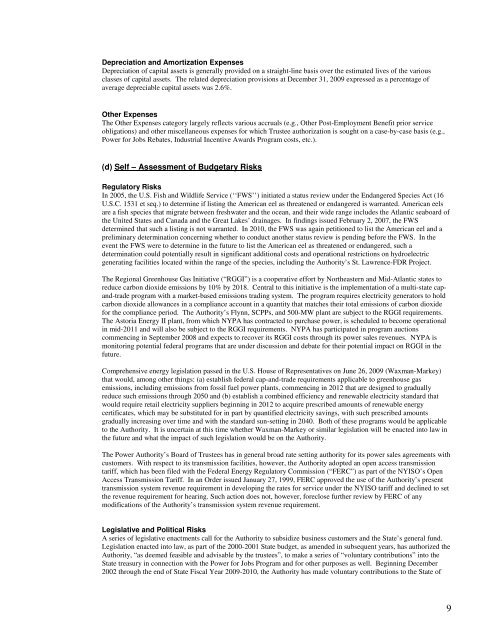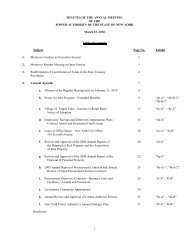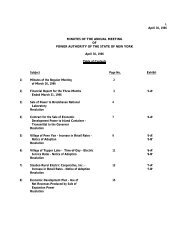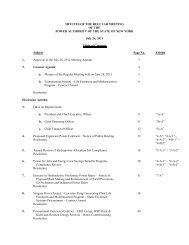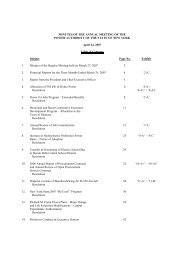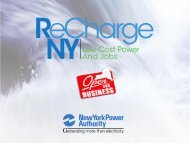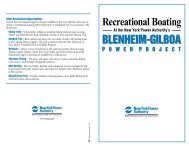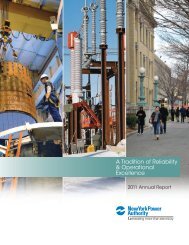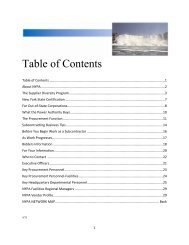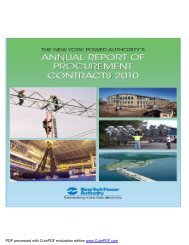PDF - New York Power Authority
PDF - New York Power Authority
PDF - New York Power Authority
Create successful ePaper yourself
Turn your PDF publications into a flip-book with our unique Google optimized e-Paper software.
Depreciation and Amortization Expenses<br />
Depreciation of capital assets is generally provided on a straight-line basis over the estimated lives of the various<br />
classes of capital assets. The related depreciation provisions at December 31, 2009 expressed as a percentage of<br />
average depreciable capital assets was 2.6%.<br />
Other Expenses<br />
The Other Expenses category largely reflects various accruals (e.g., Other Post-Employment Benefit prior service<br />
obligations) and other miscellaneous expenses for which Trustee authorization is sought on a case-by-case basis (e.g.,<br />
<strong>Power</strong> for Jobs Rebates, Industrial Incentive Awards Program costs, etc.).<br />
(d) Self – Assessment of Budgetary Risks<br />
Regulatory Risks<br />
In 2005, the U.S. Fish and Wildlife Service (‘‘FWS’’) initiated a status review under the Endangered Species Act (16<br />
U.S.C. 1531 et seq.) to determine if listing the American eel as threatened or endangered is warranted. American eels<br />
are a fish species that migrate between freshwater and the ocean, and their wide range includes the Atlantic seaboard of<br />
the United States and Canada and the Great Lakes’ drainages. In findings issued February 2, 2007, the FWS<br />
determined that such a listing is not warranted. In 2010, the FWS was again petitioned to list the American eel and a<br />
preliminary determination concerning whether to conduct another status review is pending before the FWS. In the<br />
event the FWS were to determine in the future to list the American eel as threatened or endangered, such a<br />
determination could potentially result in significant additional costs and operational restrictions on hydroelectric<br />
generating facilities located within the range of the species, including the <strong>Authority</strong>’s St. Lawrence-FDR Project.<br />
The Regional Greenhouse Gas Initiative (“RGGI”) is a cooperative effort by Northeastern and Mid-Atlantic states to<br />
reduce carbon dioxide emissions by 10% by 2018. Central to this initiative is the implementation of a multi-state capand-trade<br />
program with a market-based emissions trading system. The program requires electricity generators to hold<br />
carbon dioxide allowances in a compliance account in a quantity that matches their total emissions of carbon dioxide<br />
for the compliance period. The <strong>Authority</strong>’s Flynn, SCPPs, and 500-MW plant are subject to the RGGI requirements.<br />
The Astoria Energy II plant, from which NYPA has contracted to purchase power, is scheduled to become operational<br />
in mid-2011 and will also be subject to the RGGI requirements. NYPA has participated in program auctions<br />
commencing in September 2008 and expects to recover its RGGI costs through its power sales revenues. NYPA is<br />
monitoring potential federal programs that are under discussion and debate for their potential impact on RGGI in the<br />
future.<br />
Comprehensive energy legislation passed in the U.S. House of Representatives on June 26, 2009 (Waxman-Markey)<br />
that would, among other things: (a) establish federal cap-and-trade requirements applicable to greenhouse gas<br />
emissions, including emissions from fossil fuel power plants, commencing in 2012 that are designed to gradually<br />
reduce such emissions through 2050 and (b) establish a combined efficiency and renewable electricity standard that<br />
would require retail electricity suppliers beginning in 2012 to acquire prescribed amounts of renewable energy<br />
certificates, which may be substituted for in part by quantified electricity savings, with such prescribed amounts<br />
gradually increasing over time and with the standard sun-setting in 2040. Both of these programs would be applicable<br />
to the <strong>Authority</strong>. It is uncertain at this time whether Waxman-Markey or similar legislation will be enacted into law in<br />
the future and what the impact of such legislation would be on the <strong>Authority</strong>.<br />
The <strong>Power</strong> <strong>Authority</strong>’s Board of Trustees has in general broad rate setting authority for its power sales agreements with<br />
customers. With respect to its transmission facilities, however, the <strong>Authority</strong> adopted an open access transmission<br />
tariff, which has been filed with the Federal Energy Regulatory Commission (“FERC”) as part of the NYISO’s Open<br />
Access Transmission Tariff. In an Order issued January 27, 1999, FERC approved the use of the <strong>Authority</strong>’s present<br />
transmission system revenue requirement in developing the rates for service under the NYISO tariff and declined to set<br />
the revenue requirement for hearing. Such action does not, however, foreclose further review by FERC of any<br />
modifications of the <strong>Authority</strong>’s transmission system revenue requirement.<br />
Legislative and Political Risks<br />
A series of legislative enactments call for the <strong>Authority</strong> to subsidize business customers and the State’s general fund.<br />
Legislation enacted into law, as part of the 2000-2001 State budget, as amended in subsequent years, has authorized the<br />
<strong>Authority</strong>, “as deemed feasible and advisable by the trustees”, to make a series of “voluntary contributions” into the<br />
State treasury in connection with the <strong>Power</strong> for Jobs Program and for other purposes as well. Beginning December<br />
2002 through the end of State Fiscal Year 2009-2010, the <strong>Authority</strong> has made voluntary contributions to the State of<br />
9


